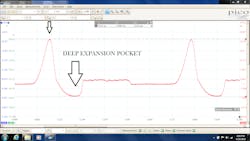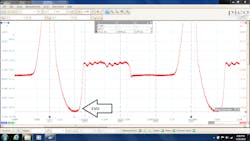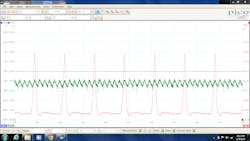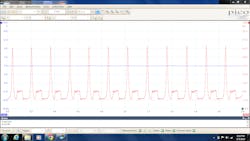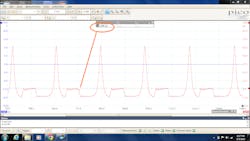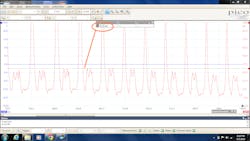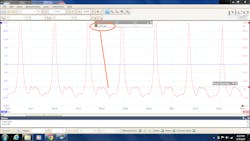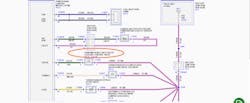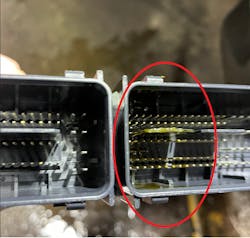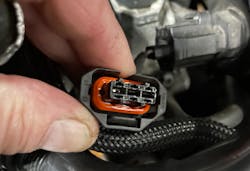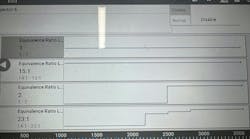Content brought to you by Motor Age. To subscribe, click here.
What You Will Learn:
• Chase the root cause fault, not the symptoms the fault creates
• Pressure waveforms allow you to see engine faults without disassembly
• Mobile technicians must rely on tests/tools that yield accuracy and efficiency, to be profitable
2006 GMC Acadia- Breathe deeply
I got called in to look at a 2009 GMC Acadia 3.6L with 93K miles on the odometer that was experiencing a “crank/no-start" symptom. The shop’s initial diagnosis was that the vehicle was over-fueling, preventing the engine from starting.
I arrived at the shop and my first course of action was to crank the engine over and listen to it (for clues of a mechanical failure) and also to see if I could detect a fuel odor. The cranking speed appeared to be excessive and the engine sounded like it had low compression (it is no secret that these vehicles have timing chain issues.). I did not smell fuel at this time.
I then connected my GM MDI2 interface and Tech2Win scan tool software to the DLC and monitored the following PIDs:
- Cranking rpm
- Engine coolant temperature (ECT)
- Throttle position (TPS)
- Manifold absolute pressure (MAP),
- Barometric pressure (BARO)
Satisfied with these values, I moved on. I next consulted service information for a wiring diagram and firing order of the engine. I wanted to move quickly and get the most bang for my buck here. I decided to disable fuel (via fuse removal) and go in cylinder #1 with my WPS500x pressure transducer, current clamp, and Pico scope from Pico Technologies I also placed an amp clamp around the positive battery cable to the starter motor for relative compression. I removed cylinder #1 spark plug and found it was black and fuel-fouled.
I first cranked the engine over with nothing in cylinder #1 and of course cylinder #1 COP unit disconnected. I wanted to try to clear any liquid fuel that may be in the cylinder. I then connected my scope, amp clamp, and pressure transducer to the vehicle.
I took a capture with the vehicle cranking. At just over 25 psi, it was obvious this cylinder had low compression. What stood out to me was the deep expansion pocket on this cranking waveform. Regarding a relative compression (RC) trace, (not shown) I noticed that not all cylinders’ RC-humps were even. I did not use an ignition synch on the capture. I used my in-cylinder channel as a “synch” so to speak. Remember, I was going for speed and getting the most data in the shortest amount of time. Using the firing order and my in-cylinder “synch,” it wasn’t pointing towards a particular bank or cylinder.I then turned my attention to the actual in-cylinder waveform. I isolated the waveform and magnified the waveform (Figure #1). I then added some cursors and could see I had low 25 psi of cranking compression and a deep expansion pocket. The expansion pocket was rounded as well. I like to see quick sharp changes.
I then decided to add some cursors to indicate 720 degrees of crankshaft rotation, or one full engine cycle (Figure #2). I then wanted to see when exhaust valve opening (EVO) occurred. EVO was occurring at approximately 55 degrees before bottom dead center (BBDC). I typically see these vehicles have EVO events in the range of 50 degrees BBDC.
I also compared this waveform with a known-good waveform I acquired from a fellow tech that I trust. This was close enough for me. The leaning compression towers were an indication of compression loss as well. But remember, this vehicle was no doubt flooded with fuel.
I considered the possibility of a restricted exhaust. I ran some horizontal cursors along the waveform and saw close to 2.5 psi of exhaust backpressure while cranking (Figure #3). I should have seen pressure values near atmosphere, or essentially 0 psi of backpressure cranking.
I then proceeded to perform the same captures on the cylinder next to #1 as a comparison (In this case, cylinder #3) and had the same results. Intake manifold design makes bank 2 in-cylinder acquisition nearly impossible. I felt very confident that this vehicle had a restricted exhaust causing the flooded” engine, resulting in the crank/no-start scenario.
I informed the shop owner of my findings. He put a tech right on the Acadia to unscrew the upstream oxygen sensors to confirm my findings. Within minutes, the Acadia roared to life and ran quite well with the exhaust restriction alleviated by the removal of the upstream oxygen sensors. At this point, I instructed the shop owner the exhaust needed to be thoroughly inspected and restricted components replaced along with an oil change and fuel trim checks. A thorough road test to evaluate for any misfires or oil consumption issues that may have contributed to the restriction was also called for.
I returned to the shop a couple of days later to diagnose another vehicle. I inquired about the Acadia and the shop owner told me that they installed new catalysts and changed the oil and filter. I asked if I could do a follow-up on the vehicle, and he obliged.
I first looked at fuel trims at idle. They were within reason and so were fuel trims at 2,000 rpm. I then revisited cylinder #1 in-cylinder compression and relative compression, cranking after disabling fuel (Figure #4); it was totally different from our original capture. Notice the lack of deep expansion pocket, no more leaning towers, and relative compression was much more even. Reinstalling the fuse for fuel, I wanted a running capture as well (Figure #5). It looks good, and notice how even the peaks are. The Acadia was back in action.
2006 Ford van- volumetric efficiency stuffiness
Our next example is a 2006 Ford Van 5.4L with 206K miles on it. The complaint is “lack of power under load.” I road-tested the van and it performed as described. I had a pretty good feel where I was heading.
I connected my Rotunda VCM2 interface along with my Ford IDS to the DLC and decided to run a KOEO self-test, and the vehicle had no on-demand or continuous memory codes. This is not surprising, since the shop that called me in to look at the vehicle had been working on the van and probably cleared codes previously.
I decided to look at a couple of scan data PIDs on a road test. During the road test, I wanted to look at load and enrichment under WOT (wide open throttle). The vehicle had low load percentage but did have enrichment. So, I was pretty confident that we were not dealing with a fuel issue such as low fuel pressure or a bad MAF sensor. The vehicle also didn’t have that ignition misfire feel. Again, I had a pretty good idea of where I was heading. I just needed to confirm my suspicions in the shortest amount of time with positive proof.
I decided to go in-cylinder with the pressure transducer. I typically will check one cylinder on each bank on these vehicles. I went first in cylinder #4 (on bank 1) after disabling spark and injector pulse for that cylinder. I will typically check at an idle and snap throttle.
I zoomed in and added a horizontal measurement cursor. Again, I’m interested in the pressure rise just after EVO. Ideally, I should see atmospheric pressure at an idle and some low pressure during a snap throttle event. Here we see we have 1.6 psi at an idle (Figure #6) and 31.3 psi on a snap throttle (Figure #7).
I went in cylinder #5 (on bank 2) with the pressure transducer. Again, disabling spark and fuel injector for that cylinder, I repeated the idle and snap throttle events. Zooming in and adding a horizontal cursor measurement, a very different story was told for this bank’s breathability. At an idle, atmospheric pressure was present just after EVO and about 3.5 psi during a snap throttle event (Figure #8). This bank can exhale, whereas bank 1 is restricted.
I informed the shop owner of my findings and showed him my results. I also advised him that catalysts usually don’t clog on their own. There are many factors that can cause such failures (such as misfires, fuel trim issues, oil consumption, etc.), and l will need to be evaluated, especially on a high-mileage vehicle such as this one.
I checked in with the shop owner a couple of days later. He informed me that he changed bank 1 catalyst and inspected the rest of the exhaust system. A follow-up road test confirmed that the van had its power back.
2017 Ford Escape- When a solenoid circuit code goes sideways
“Cause and effect” is one of the many daily occurrences we see in the automotive industry. Neglecting to change your oil or running your engine low on oil undoubtedly will have a negative impact on the engine's lifespan. The effect is a bad engine; the cause was lack of maintenance. But what happens when we see strange cause and effect issues? Well, this is one such case.
A 2017 Ford Escape 1.5 L with 205K miles was being addressed. This vehicle is a security vehicle for a local school, so it sees its fair share of idle time. The shop had the vehicle for a check engine lamp illuminated. They scanned for DTCs and diagnosed the fault as a bad coolant bypass solenoid. They ordered one from Ford, installed it and still had the same code. They then installed a second one from Ford and visually checked the wiring. After the second installed part they had the same issue and that is when they called me.
I inspected the vehicle, and it was in pretty good shape for the mileage it had. I ran a KOEO self-test. The vehicle had a code P2681 on demand for a coolant bypass solenoid. After visually inspecting that the shop changed the correct solenoid, I went to work. Looking at the code description, the code was for an open circuit. Ford pinpoint testing is a series of checks (check this for an open, check that for a short, etc. I needed to check this circuit fast and efficiently. Looking at the wiring diagram I could not find an engine coolant bypass valve. I referred back to the pinpoint test.
The engine coolant bypass valve is also called a transmission fluid heater coolant control valve. Lo and behold, I located that component by name in the wiring diagram (Figure #9).
So, 12V is fed through fuse F34 (in the battery junction box) to circuit CBB34 (VT/BN), to solenoid. The control side of the solenoid goes from back to the PCM connector C1551E, terminal #17 (on circuit CE172 (GN)).
I was able to get to the solenoid. I unplugged the solenoid and checked terminal tension at the connector and was satisfied we did not have spread terminals. I then reconnected the solenoid and back-probed the solenoid connector, first on the power feed wire and then on the control side key on, and I had battery voltage on both. This temporarily ruled out S110 being a potential issue for a complete break.
After a visual inspection of the exposed harness, I had to gain access to the PCM and test at the PCM connector to confirm circuit integrity. Getting to the PCM on these vehicles is no easy task. The left front wheel and inner fender well had to be removed. I was then greeted by the plastic box forward of the wheel that houses the PCM. I noticed that the PCM harness going into the plastic PCM housing box was quite oily. I attributed this to the high mileage of the vehicle.
I removed the cover and exposed the PCM. I took off the PCM connectors and was surprised to find oil in one of the PCM connectors and the PCM itself (Figure #10). Now I knew why the harness was oily as well. Referencing the wiring diagram again proved this was connector C1551E (the very same connector that housed my problem circuit that I was chasing). I continued to check my problem circuit. I first verified that the circuit was complete. I reconnected my PCM connectors, turned key on and back-probed circuit CE172 at the PCM connector C1551E and measured 12V. This verified a “complete” circuit.
I disconnected the PCM connectors again and powered up F34 fuse in the battery junction box with a jumper wire. This was a necessary step because with the PCM disconnected, that fuse would not be supplied voltage with the key on (as the PCM power relay would not be activated with the PCM disconnected).
I then front-probed terminal #17 at the disconnected C1551E PCM connector and grounded the circuit and listened for an audible click from our offending solenoid. A distinct click could be heard. I then checked the amp draw of the circuit when I actuated it. I was satisfied that the circuit was intact and not drawing too much amperage. I then reconnected the PCM connectors and reran my KOEO self-test and still had a code P2681 on demand. This is always a wise step, as I could have inadvertently moved a harness and temporarily “fixed” the issue.
So, it was pretty clear that this little Escape would need a PCM. But, where was this oil coming from? Looking at the pinout for C1551E, there were a couple of culprits. I was looking for components that spend their lives in oil. There was an engine oil level switch and both exhaust and intake cam sensors. I looked for an oil level switch and was never able to find one. I then looked at the cam sensors and hit paydirt. The exhaust cam sensor connector was nice and dry. The intake cam sensor was wet with engine oil, and there was a pool of oil in the sensor itself (Figure #11).
This was the offender for the oil migration. Over the years I have seen various liquids such as washer fluid, oil, and coolant end up in modules through capillary action. At times they seem to defy gravity. Sometimes it is quite bizarre.
I advised the shop of my findings and gave some options. After discussing with the Escape owner, they elected to change the cam sensor and pigtail. They hung the harness up for a couple days to get rid of most of the oil in the harness. They cleaned the PCM connector and were going to get a Ford remanufactured PCM. This was the decision between the shop and the vehicle owner.
A few days later I arrived to program the remanufactured PCM. The harness seemed to be pretty dry and oil-free. I installed the remanufactured PCM. I programmed it, ran vehicle theft programming, and other setups as well. The vehicle ran well and had no more codes for the engine coolant bypass valve circuit.
I have no doubt that the oil migration into the PCM caused this failure. It was indeed a strange case of cause and effect. With all of those factors applied, is there really anything we are not capable of properly diagnosing?

